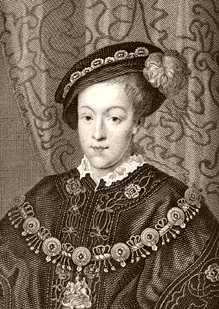A child king: Edward VI
Edward VI was crowned at the age of nine; he was a sturdy child and, like his father, grew to enjoy the aristocratic sports of hunting and tilting. But he was also extremely well- educated in the classics, theology and humanist literature, and differed from Henry VIII in being a radical Protestant.
Had he not sickened and died of tuberculosis, Edward's religious convictions might have been even more divisive than his sister Mary's attempt to restore Catholicism.
Although Henry VIII named a Council to govern during Edward's minority, the Council became dominated in turn by the dukes of Somerset* and Northumberland*. Both men pushed strongly to make England a fully Protestant state.
A nine-day Queen
Lady Jane Grey was the daughter of Henry Grey, Duke of Suffolk, and Frances Tudor (Henry VIII's niece by his sister). Scholarly and unambitious, Jane rose to brief majesty only as a pawn in the designs of her father and the Duke of Northumberland, whose son she had been compelled to marry.
Upon Edward VI's death, Northumberland forced members of the Council to recognize Jane as Edward's designated heir; at the age of 15 she was thus whisked to the Tower of London, where she reigned for nine days and then became a prisoner.
Unexpectedly, the Catholic Mary Tudor rallied strong support for her own claim to the throne; the Council accordingly revoked its earlier proclamation made under duress and hailed Mary the rightful Queen. Mary knew Jane's innocence and therefore had her sentence for treason suspended, but her father's support of Wyatt's Rebellion made her too much of a potential threat to the newly Catholic crown*.
Jane was executed in 1554 along with her innocent husband, her father, and the shifty Northumberland (who at the end declared himself a Catholic after all).
Footnotes
-
Somerset
In a political attempt to establish a broad base of support, Somerset instituted moderate reforms; but during his protectorship there was an upsurge of anti-Catholic feeling, now able to assert itself after the death of Henry VIII. Many Protestant exiles (see below) migrated from the continent, taking positions in English universities; some of them helped Archbishop Cranmer produce the first Book of Common Prayer, which the Act of Uniformity (1549) imposed upon all churches in the realm.
Scattered rebellions were harshly oppressed, caused in the west by religious conservatism and in the east by demands for agrarian reform. Following one rebellion, the Duke of Northumberland used his power as commander of the army to overthrow Somerset; Somerset was duly "tried" and executed for treason.
Protestant exiles
At this time the Catholic Reformation was gaining sway in Germany and Charles V had just defeated a number of Protestant princes; as a result, many reformers sought new ground in which to foster their beliefs.
-
Northumberland
Northumberland proved more ruthless than Somerset in his grasp for power, and consequently used Protestantism to a greater extent as vehicle to further the power of his political position. He was also more competent in handling crown finances. (However, he naturally pursued personal profit as rapaciously as was usual for government officials of his time.) With the young King's full approval, Cranmer's second Prayer Book was enforced under a new Act of Uniformity (1552); all forms of idolatry were forbidden; and most Church plate was confiscated. Northumberland also took the more long-term measure of raising the quality of the coinage (debased in value since the reign of Henry VIII to bring short-term profits to the crown).
When Edward's health deteriorated alarmingly, Northumberland conspired with him to protect the future of the Reformation by naming the King's cousin Jane Grey as heir; Edward's half-sisters Mary and Elizabeth were again labelled illegitimate.
-
Elizabeth vs. Mary
A similar situation arose later when Elizabeth was confronted by Mary, Queen of Scots (except Mary Stuart was by no means innocent, and it was a Protestant crown that was threatened).
